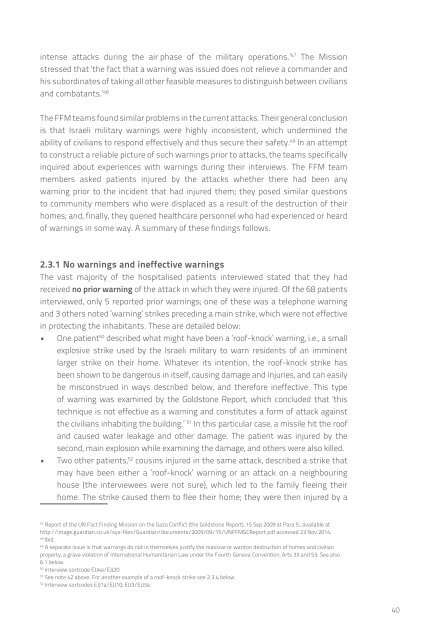HHo0s
HHo0s
HHo0s
Create successful ePaper yourself
Turn your PDF publications into a flip-book with our unique Google optimized e-Paper software.
intense attacks during the air phase of the military operations.’ 47 The Missionstressed that ‘the fact that a warning was issued does not relieve a commander andhis subordinates of taking all other feasible measures to distinguish between civiliansand combatants.’ 48The FFM teams found similar problems in the current attacks. Their general conclusionis that Israeli military warnings were highly inconsistent, which undermined theability of civilians to respond effectively and thus secure their safety. 49 In an attemptto construct a reliable picture of such warnings prior to attacks, the teams specificallyinquired about experiences with warnings during their interviews. The FFM teammembers asked patients injured by the attacks whether there had been anywarning prior to the incident that had injured them; they posed similar questionsto community members who were displaced as a result of the destruction of theirhomes; and, finally, they queried healthcare personnel who had experienced or heardof warnings in some way. A summary of these findings follows.2.3.1 No warnings and ineffective warningsThe vast majority of the hospitalised patients interviewed stated that they hadreceived no prior warning of the attack in which they were injured. Of the 68 patientsinterviewed, only 5 reported prior warnings; one of these was a telephone warningand 3 others noted ‘warning’ strikes preceding a main strike, which were not effectivein protecting the inhabitants. These are detailed below:• One patient 50 described what might have been a ‘roof-knock’ warning, i.e., a smallexplosive strike used by the Israeli military to warn residents of an imminentlarger strike on their home. Whatever its intention, the roof-knock strike hasbeen shown to be dangerous in itself, causing damage and injuries, and can easilybe misconstrued in ways described below, and therefore ineffective. This typeof warning was examined by the Goldstone Report, which concluded that ‘thistechnique is not effective as a warning and constitutes a form of attack againstthe civilians inhabiting the building.’ 51 In this particular case, a missile hit the roofand caused water leakage and other damage. The patient was injured by thesecond, main explosion while examining the damage, and others were also killed.• Two other patients, 52 cousins injured in the same attack, described a strike thatmay have been either a ‘roof-knock’ warning or an attack on a neighbouringhouse (the interviewees were not sure), which led to the family fleeing theirhome. The strike caused them to flee their home; they were then injured by a47Report of the UN Fact Finding Mission on the Gaza Conflict (the Goldstone Report), 15 Sep 2009 at Para 5., available athttp://image.guardian.co.uk/sys-files/Guardian/documents/2009/09/15/UNFFMGCReport.pdf accessed 23 Nov 2014.48Ibid.49A separate issue is that warnings do not in themselves justify the massive or wanton destruction of homes and civilianproperty, a grave violation of International Humanitarian Law under the Fourth Geneva Convention, Arts 33 and 53. See also6.1 below.50Interview sortcode EJJ4a/EJJ2051See note 42 above. For another example of a roof-knock strike see 2.3.4 below52Interview sortcodes EJJ1a/EJJ10; EJJ3/EJJ3a40


